The best places for Japanese whisky, craft beer and sake in Singapore
There’s more to it than just izakaya culture
As much as Singaporeans are obsessed with Japanese food, it merits mention that Japanese alcohol is right up there too. And we don’t just mean sake—although Singapore is certainly developing a taste for the good stuff. We also mean all those award-winning whiskies that are sweeping up blind tastings in recent years, and of course, craft beers. Here’s where to try it all in Singapore

It might be an oldie, but it’s a goodie. This place stocks well over 1,000 Scotch whiskies on its lofty shelves covering every distillery in Scotland from affordable drops to truly astonishing bottles like the Mortlach 70-year-old, but the hidden gem here is its Japanese whisky offerings. They have a selection of over 250 Japanese whiskies, ranging from well-known names like the Yamazaki, to lesser known but equally enticing distilleries like the Karuizawa, Shinshu Mars and Akashi.

Sample the unusual pairing of sake and Spanish tapas at this gastro bar. This casual Spanish-Japanese eatery by Chef Pepe Moncayo has close to 100 sake labels in the glass-paned cellar and of course, a sake sommelier on hand. On offer are premium sake offerings from renowned distilleries like Juyondai, Nabeshima and Isojiman. Besides small plates, the restaurant also offers omakase and set lunches (from $38), with items such as cold capellini with tobiko and bamboo clam; and Spanish pork with organic mushrooms and ginger rice.

Located right across Ippudo Ramen, 12-seater sake gastrobar offshoot of the famous noodle chain carries around 70 bottles of sake from over 20 sake breweries all over Japan, and the space doubles as a bottle shop, too. Pair each sake with otsumami, or bar bites like oden ($2 per ingredient), a yong tau foo-like dish comprising items like a boiled egg, daikon, fishcakes and konjac jelly; crispy corn ($6) and beef tataki ($6). Don’t worry, there’s still their Hakata-style ramen available, too.

Helmed by Ginza celeb bartender Daiki Kanetaka, this bar at Bukit Pasoh does interesting Japanese-inspired cocktails alongside its impressive array of Armagnac, calvados and imported blends of Japanese whisky and cherry brandy. There’s not much food at this 28-seater space, but who needs bar bites when you're in good company? It’s not cheap, but with Kanetaka’s elegant, theatrical antics and impeccable attire, the entertainment value is pretty priceless—not to mention the drinks are good.

Perched over the hustle and bustle of Orchard Road is the massive but cozy restaurant Kuvo and its attached bar Elixir. The space, outfitted with lots of dark wooden shelves and a long lit bar, is helmed by Japanese bartender Yutaka Nakashima who shakes up Japanese inspired cocktails. For whisky, they have single and double malt offerings from Yamazaki, Yoichi, Miyagikyo and cult favorites like the Hibiki and Taketsuru. They also offer a glossary of mood words to help you pick your very own bespoke cocktail.

This underground bar at the Forum on Orchard is known for its bustling and dimly lit, chic atmosphere and for its Japanese-style drinks. Whether it's using sake or other Japanese ingredients, the concoctions here are inventive and really pop against the muted backdrop. Splashes of color come from the origami-like cascades by the wall, and you can order food from Uma Uma Ramen upstairs to fulfill that midnight craving.

There’s more to Japanese drinking than fancy whisky and bottles of sake. The Japanese craft beer trend has been going steady in Singapore for a while, and one of the only dedicated Japanese craft beer bars in Singapore, Jibiru is pretty well-trafficked as it's located in 313@somerset. Nonetheless, it loses none of its charm with heavy wooden tables and a breezy alfresco atmosphere. Here, you'll find beers like the well-known Hitachino, as well as an interesting Minoh Cabernet made with grapes. FYI, they also just opened the more upscale Craft Beer Bar Takumi.

A relative newcomer is the bar attachment to Japanese kaiseki restaurant Ki-sho at Scotts 29 lifestyle enclave—and it’s perfect for fans of sake. Dim lighting, a cozy wooden top bar and plush leather seats add to the sexiness of this bar. A must-try is Kakure's house sake, the Tatenokawa Junmai Daiginjo, Nakadori Ki-sho label ($60) which features a delicate aromatic brew with a fruity after taste. If you prefer something that’s more soft and crisp, try the Kinshi Masamune, Matsuya Kyuubei Junmai Daiginjo label ($80) with a clean, fresh aftertaste that goes easy on the palate.

Specializing in sake, shochu and all things Japanese and boozy, this Singaporean offshoot of the well-known Japanese liquor store is a place to discover a still relatively underappreciated drink. Their dark and non-descript location in the Robertson Quay area belies its immense popularity with Japanese and non-Japanese alike. The diffident store manager Naoki Satoh is a wealth of knowledge, whether you’re drinking in (with their excellent drinking snacks) or buying bottles to take home.
This sleek, narrow space on Upper Circular Road is a mix of modern and traditional. Near the entrance is a well-lit cellar made of white onyx, and inside is a Japanese cedar bar counter. On the menu are top notch drinks: a well curated selection of mostly Old World wines (from $20/glass; $68/bottle) and an exhaustive list of whiskies, with options like Yamazakura blended shot ($20) as well as blowout bottles such as Karuizawa Samurai Cask 1984 ($11,250). The bar bites—including duck rillettes ($12) and cheese ($6 per 25g)—are a great complement to the swish sips, and owner and sommelier Daisuke Kawai is a gem.
Like what you see? For regular updates on Japanese food and drink in Singapore, follow Bite! Japan on Facebook.
Advertisement
A cornerstone of Japanese cuisine is amazing ingredients, and there is no better way to enjoy Japan’s best meaty offerings than by grilling them up simply at the table and enjoying them will little more than a few dipping sauces. Here are Singapore’s best yakiniku restaurants, where you can do just that.
For a solid mid-week DIY Japanese grilling experience without the frills, look no further than this reputed casual joint that usually draws the Japanese expat crowd. Each table comes equipped with a charcoal grill—opt for an outside table if you’re worried about smoke in your hair—and the menu offers a lengthy list of various cuts like skirt, short rib and tenderloin. The house sauces that come with are really half the fun.

It doesn’t get more glitzy than this spot at the fancy Mandarin Gallery, which specializes in chilled, not frozen, Japanese black wagyu, offering cuts like flank steak, skirt steak and short rib. On the non-beef front, there is Kurobuta pork jowl and pork belly. To be clear, though, with a location this central and a decor this refined, you can expect the meal to be a splurge.

Not only does this Osaka chain specialize in yakiniku, it also serves gyu nabe, or hearty beef hot pot. Inside the 50-seater, booth seats make for cozy dining around the grill, while customized ventilation hoods make sure diners don’t walk out smelling like grilled meat. While decor is sparse, there is an arresting feature mural of the iconic Mount Fuji. Yakiniku fans should get the Kinoshita Special BBQ set, with several cuts of Hokkaido beef.

Duxton Hill frequently sees new Japanese additions, but this one is worth taking note of. The standout feature at this modern 28-seater is their use of crystal grilling plates instead of the usual metal grills. These plates, specially imported from Japan, retain heat very well so only a low heat is needed to grill the meats. This helps retain the meats juices and produces no smoke. This dinner-only yakiniku joint imports its high quality beef from Kagoshima and Kumamoto. Their non-cooked beef, like the wagyu tartare and wagyu sashimi are also great.
This huge yakiniku chain may have over 600 outlets in Japan and four in Singapore alone, but you would never guess it from the cozy, dimly lit and modern atmosphere of their renovated branch at Chijmes. Their big thing is Kagoshima wagyu, and the Kurobuta pork selection is good, too. You even have the option of grilling up a Chateaubriand with little more than truffle salt.

Not only is this yakiniku spot well-located in bustling Vivocity, it’s also right next door to its sister venue, Shabuya Shochu Bar, making it a great spot for meaty dinner followed by casual drinks. And with their high-performance exhaust system over each table, you can head on over to your next party without worrying about smoke in your hair. Highlights of the meat-centric menu include Japanese Miyazaki beef and Kurobuta pork, both highly prized for the premium quality.

Tenkaichi is so confident about the affordability and quality of its produce that it offers a “best price guarantee”, promising to beat any restaurant with a cheaper price by a further 10 per cent. What’s more, there’s a view of the Marina Bay waterfront. On the menu are a variety of premium and more affordable cuts, but the highlight has got to be the wagyu tokujo karubi, a grade A5 finely marbled black cattle wagyu from Miyazaki prefecture.

Since the first store in Ayase, Tokyo, Heijoen has expanded over nearly half a century to 30 outlets all over Japan. Its glorious debut in Singapore is at none other than the buzzing Japan Food Town at Wisma Atria, sporting a modern, clean-lined woodwork interior, with soft lighting. The highlight of the menu has to be the deluxe cuts of A5 Wagyu Beef directly imported from Kagoshima, but don’t be surprised to also find some Korean staples like kimchi, namul, or bibimbap on the menu.
Robertson Quay may have tons of Japanese places but this BBQ joint specializes in Yazawa wagyu beef from Japan. It does come at a pretty penny with cuts like a chuck-eye Zabuton costing over $60 per serving. The place also has other beef options like kalbi, Kurobuta pork and some chicken in spicy miso, too.

This sleek and minimalize space specializes in omakase-style barbecue including dishes like niku somen (raw wagyu sliced into thin “noodles” and topped with dashi stock, grated yam and seaweed) and yaki suki (sliced wagyu with sweet sukiyaki sauce and raw egg). Each course menu comes with rich cuts like chuck eye and sirloin, plus more adventurous cuts like beef tongue—all from Miyazaki, Kagoshima and Iwate prefectures.
Like what you see? For regular updates on Japanese food and drink in Singapore, follow Bite! Japan on Facebook.
Advertisement
Novice Japanese food fans might not know this, but the archipelago of Okinawa is famous for more than just its US airbase. Due to its geographic isolation and its historic status as a trading port, it also has a food culture and cuisine unlike anything else you’ll find in Japan. Said to derive influences from China and Southeast Asia, Okinawan dishes feature robust flavors and indigenous ingredients. Here are some highlights to try—and where to do it in Singapore.
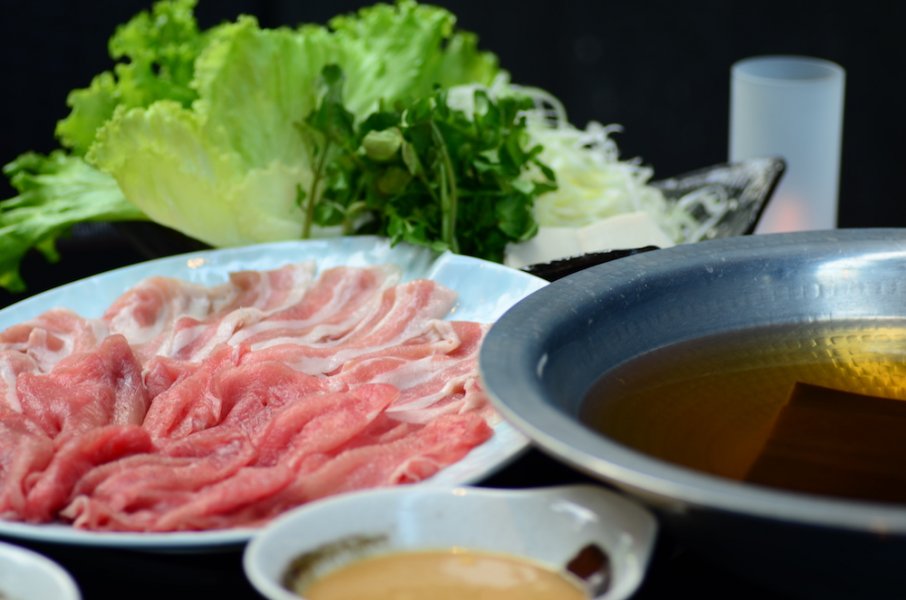
Okinawan cuisine is big on meat, especially pork, and the people of the island are famously said to consume every part of the animal. Agu is a breed of black pig indigenous to the land and due to its beef-like marbling, sweet taste and relatively small numbers, particularly after World War II, it is a prized meat.
Where to try it: Dashi Master Marusaya on Robertson Quay, famous for its nuanced and deep-flavored dashi stock, showcases agu pork in a simple, unadulterated way: slices of the meat are served alongside a hot pot full of stock, shabu shabu-style.
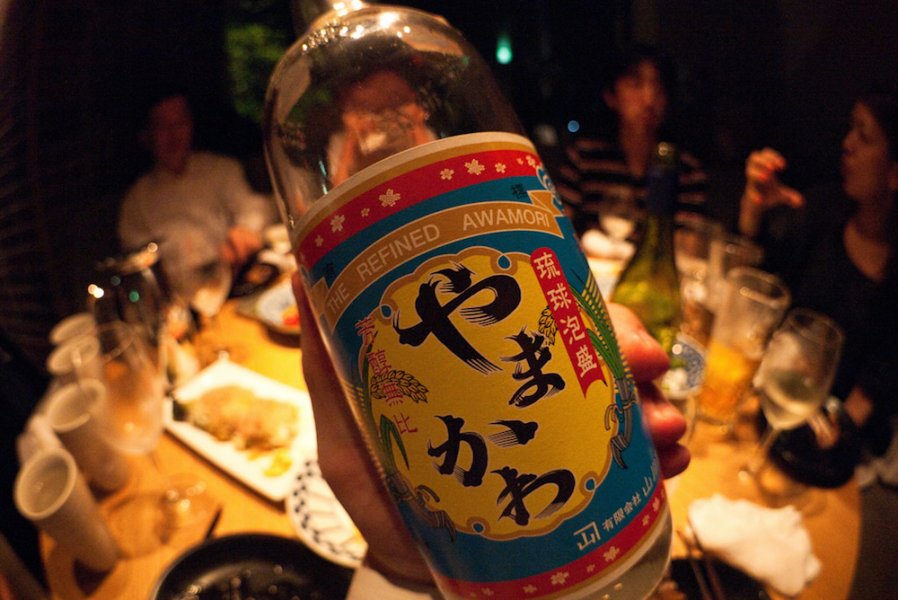
Photo credit flickr user nokton
This distilled spirit is traditionally made from rice grains indigenous to Okinawa—though today it is more likely to be made from Thai rice. Awamori is a more refined cousin of shochu and a popular drink for social gatherings on the island. It is enjoyed on the rocks, or splashed with a bit of water—although awamori cocktails are increasingly common.
Where to try it: The sleek, wood-panelled and perpetually packed izakaya En Japanese Dining Bar has a pretty wide selection of drinks, including several awamori.
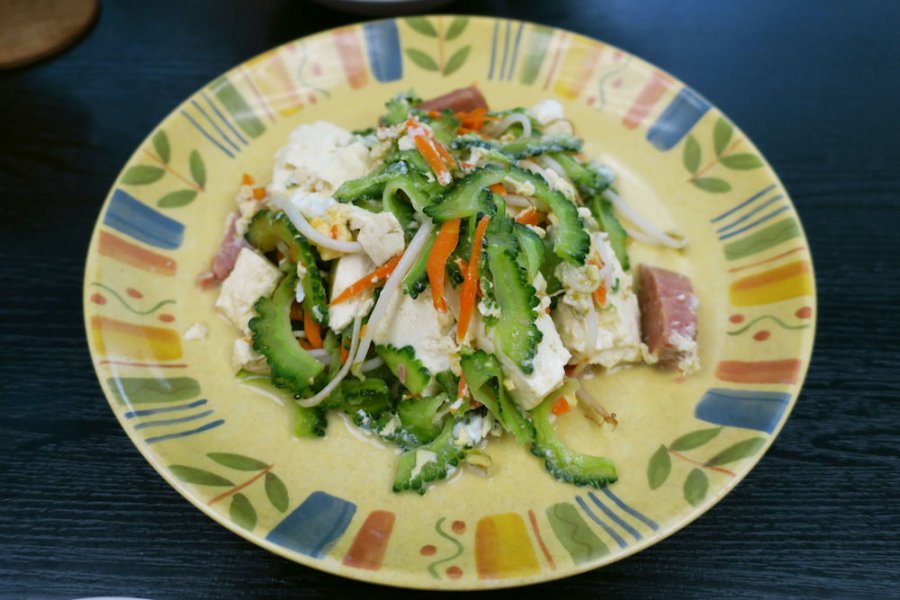
Photo credit flickr user ekkun
No primer on Okinawan cuisine would be complete without this dish. This stir-fry of bitter melon, tofu, pork and eggs is equal parts comforting and delicious. Goya refers to the bitter melon, which is a beloved vegetable on the island, and appears in many other forms, including salads and tempura.
Where to try it: Drinks aside, En Japanese Dining Bar’s menu features many Okinawan dishes, including this one.
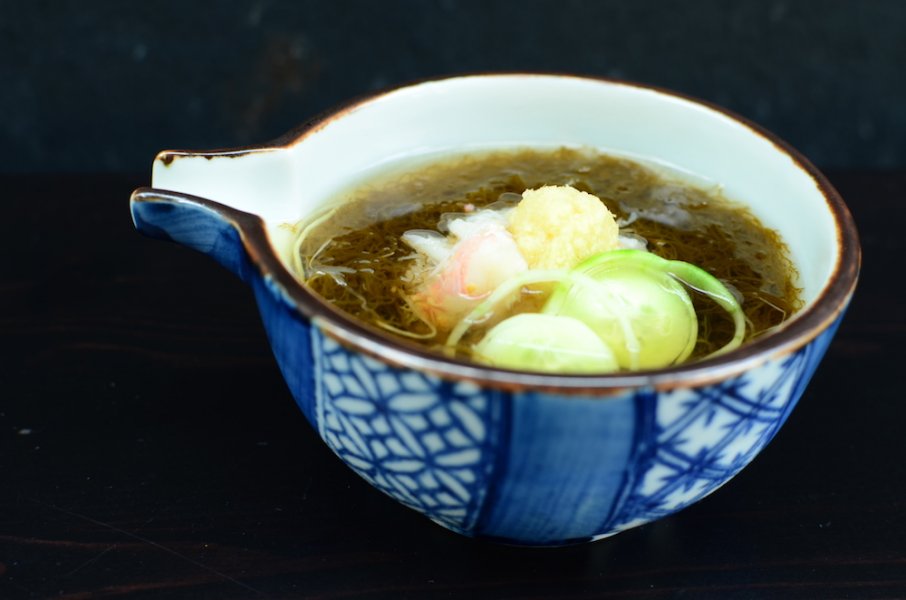
The mozuku seaweed found in the oceans of Okinawa is particularly famous for its thickness, packed nutrition profile, tumor-suppressing properties and low calorie count—making it both extremely healthy and also a great diet food.
Where to try it: Although not technically an Okinawan restaurant, Dashi Master Marusaya appreciates and employs the special properties of certain ingredients from the island. Along with agu pork, chef Eno also serves a light stew, involving her famous dashi, mozuku seaweed, spring onions and other seafood.
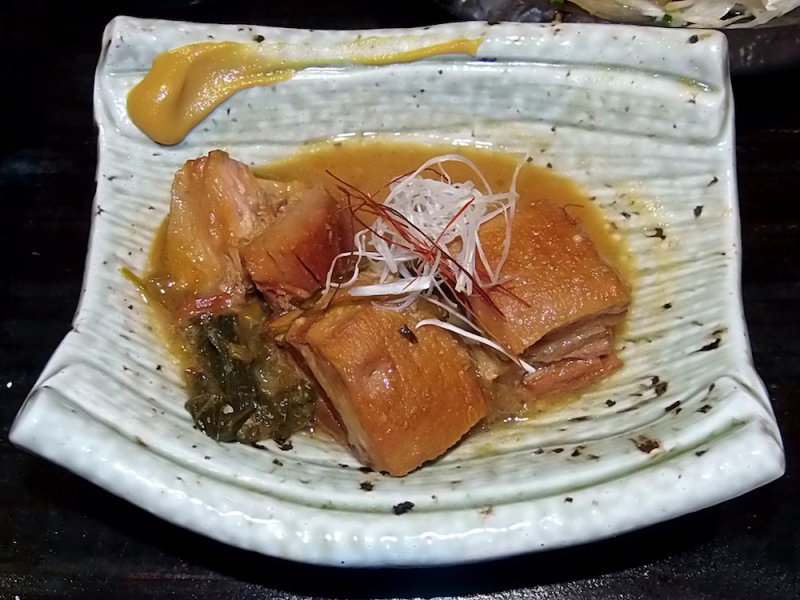
Photo credit flickr user Nemo's great uncle
Inspired by centuries of Chinese trade influence is this dish of long-braised pork belly. The skin is left on, and the pieces of meat are slow-stewed with soya sauce and brown sugar which gives the dish a rich glaze.
Where to get it: Tucked in the basement of Liang Court, already famous for its plethora of Japanese shops, restaurants and supermarket, is the all-Okinawan restaurant Nirai-Kanai (B1-01/02 177 River Valley Rd., 6339-4811). In addition to rafute, they also serve goya champuru and traditional Okinawa soba, among other dishes.
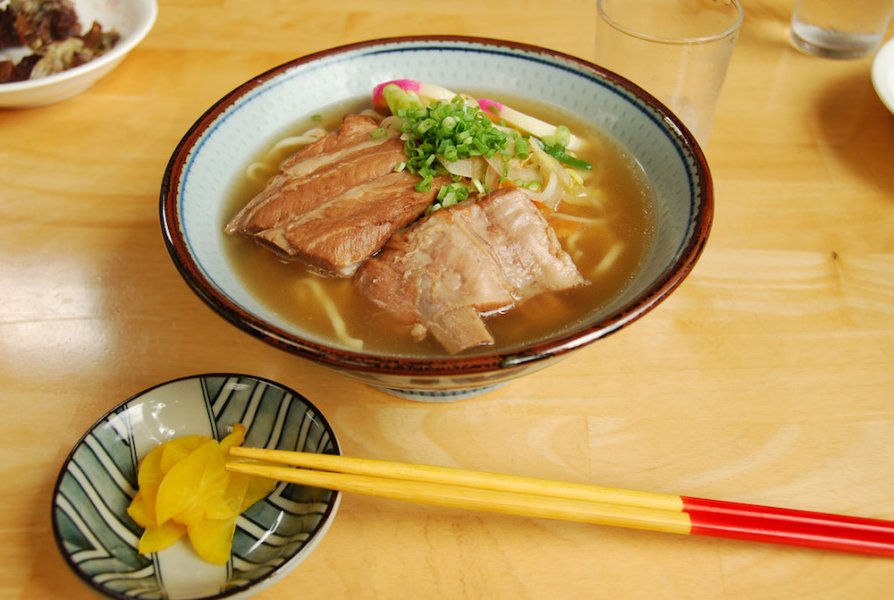
Photo credit flickr user sho(255)
Combining two great Okinawan food obsessions, pork and noodles, soki soba is a light noodle soup involving simmered, fall-off-the-bone pork spare rib, soft soba noodles and additions like tea-pickled eggs, pickles leeks and spring onions. The clear broth is simple, made with kelp, bonito flakes, sake and other flavorings.
Where to try it: It might not have a website or a Facebook page, but what Nirai Kanai does have is pretty much all the iconic dishes of Okinawa, including this one.
Like what you see? For regular updates on Japanese food and drink in Singapore, follow Bite! Japan on Facebook.
Advertisement
If you think you know the best places to get ramen in Singapore, think again. The landscape has changed a lot in recent months, and while the old stalwarts remain steadfast, there are plenty of new and exciting contenders. Here’s an updated list to make your way through soon.
The Central is where many established Japanese restaurant chains reside, including this 20-something year-old brand with over 50 outlets in Japan, tucked away in a tricky-to-find hallway but worth the hunt. They specialize in cha shu, miso ramen and shio ramen. It’s easy to see why the place has remained so popular all this while: the tonkotsu-broth is so rich and creamy it might as well be pork-flavored buttermilk, and the thin, springy, al dente noodles absorb the flavor of the soup nicely—to say nothing of the equally solid sides such as char shu rice, salmon roe rice and more.

One of Singapore’s (and indeed the world’s) most well-known ramen chains, Ippudo’s Hakata-style tonkotsu-based bowls are eternal hotsellers. Try the original Shiromaru broth, with thin and straight Hakata noodles. You have the option of also adding yummy toppings like pork belly, tamago and more. For a kick, there’s their sublime Akamaru Shin-aji, which also gets extra miso paste and garlic oil. There are other ramen options, too, along with sides like their signature gyoza, the spicy shrimp mayo and refreshing cucumber salad.

In naming his ramen bar after a Japanese phrase that means “to finish eating every last bit of your food” Melvin Ang isn’t overstating things. With zero formal training in cooking, Ang set out a few years ago to learn everything he could about making amazing ramen, travelling to Japan and learning from the best. What you have at Kanshoku’s three branches across Singapore is delightful twists on traditional ramen. Whatever you do, don’t miss the signature dry truffle ramen, Kanshoku’s most popular dish, selling 7,500 bowls every month. French angel hair pasta is tossed in truffle oil and comes topped with a sous-vide egg, cha shu and Italian black truffle shavings. Savory to the max!

Tanjong Pagar’s Orchid Hotel is no stranger to delicious and affordable food, with several big-deal Japanese restaurants along the same strip. Among them is this tonkotsu ramen gem, by celebrity chef Keisuke Takeda, behind a veritable global empire and certainly Singapore’s biggest ramen chain. The space is small, seating only about 20 or less, and has homey little touches like small mortars and pestles for you to grind up some sesame seeds and bowls of boiled eggs. Ramen starts at under $12, going up in price with toppings like a sheet of Japanese seaweed and flavored egg. Brothwise, your choices include the classic tonkotsu, and two spicy varieties: black pepper and red chilli. They’re all good.
With four branches in Singapore, Marutama is a hit among those who aren’t crazy about the tonkotsu broth. The decor is casual, with monochromatic and wooden Japanese touches like beige panelled walls and open kitchens, making Marutama more apt for a casual lunch than date night. On the menu, you’ll find MSG-free broths involving pure chicken and even seven types of nuts. Seafood lovers should try the unusual Ebi Ramen, which is topped with fresh tiger prawns. Also worth saving space for are their side dishes: yaki cha shu, gyoza, chawan mushi and kakuni, or pork belly stewed in a house sauce.

Hailing all the way from Niigata in Japan, what sets this ramen shop—with only two branches in Singapore— apart is the broth, of course. Chicken, tonkotsu, two types of dried sardines are simmered for over six hours to create the signature shoyu-based dashi. They also take their noodle-making seriously, doing it fresh and in-house every day, resulting in firm, springy noodles that retain the flavors of the broth without going soft. The classic Niigata shoyu ramen aside, try their Tori X Miso broths, too, made with an in-house special miso. Whatever the broth, you will no doubt order up extras of their delicious aburi cha shu.

The hot ramen bar opening of the year, Tokyo’s Michelin-starred Japanese Soba Noodles Tsuta now has an outpost, an 18-steater at Pacific Plaza and the first outside of Japan. The secret to its delicious ramen is the attention chef Yuki Onishi pays to the details—most notably he works with a specific soy sauce brewer in Wakamaya Prefecture to create a customized shoyu, mixing it with two others for the legendary broth. You also have the option of a miso broth and a shio broth—the latter has a tantalizing and unusual list of ingredients, including red wine and rosemary.

Takumen’s claim to fame in Japan is its online catalogue of over 100 types of ramen, available for delivery nationwide. The Singapore offshoot may not have a similar promise, but what it does have is above and beyond the competition: a rotating list of six ramen types—a variety that rewards repeat visitors and explains the steady stream of CBD office workers you’ll find here. Try bowls like the Bingiri, which is popular among the fishermen of the Chiba coast and is spiked with chilli, and the award-winning shio ramen Hajime, which skips the tonkotsu and involves a light chicken broth.

There is more to this unassuming place at The Forum than just the secret entrance to the achingly cool Japanese bar, The Horse’s Mouth. Specializing in Fukuoka-style noodle bowls, Uma Uma Ramen distinguishes itself as a rare place doing light broths and even dry ramen. Highlights include the mazesoba, which sees dry noodle served bathed in a savory shoyu sauce, topped with leeks, spring onion, bamboo shoots and of course their delicious cha shu. Save room for the spicier Tan Tan Men, which has a strong sesame base and is topped with chilli oil, minced pork and egg. Oh, and do head down to the bar afterwards!
Like what you see? For regular updates on Japanese food and drink in Singapore, follow Bite! Japan on Facebook.
Advertisement
Singapore is full of sushi options, from the supermarkets to the six-star hotels. These are the ones that stand the test of time, that bring a touch of originality to the traditions they follow and ones that offer some of the best value-for-money options we’ve seen.
It may be a little difficult to find, but this exclusive 10-seater restaurant at Chijmes specializing in aged sushi is worth the effort. Alongside the 180 year-old hinoki cypress wood sushi counter, the star of the place has got to be Nakano native sushi chef Taku Ashino, who has been making sushi for over 10 years, most recently during a three-year stint at Hide Yamamoto’s restaurant at Marina Bay Sands. Through his focus on aging his fish, he aims to soften the sinews and bring out a greater depth of flavor. Don’t miss the tuna marinated with soy sauce, aged for a week, and the botan ebi, aged three days.
A veritable and long-standing destination for sushi lovers, this Orchard Road omakase stalwart has recently had a relocation and facelift within Mandarin Gallery, though you can still count on the presence of the talented Kenjiro “Hatch” Hashida—son of celebrated sushi master Tokio Hashida. Hatch flies fresh seafood in from Tsukiji Market an impressive four times a week, but also from Hokkaido. At his omakase, expect highlights like chutoro from Kyushu and kinmedai fish from Aomori.
Being among the hippest Japanese restaurants in town—all exposed pipes and concrete floors—doesn’t diminish the fact that IKYU’s sushi program is among the best in the city. The affable chef Takuma Seki, who grew up spending time on his grandmother’s farm in Japan, sources top ingredients from his native Niigata, especially when it comes to rice and sake. Grab a seat at the sushi counter and let him regale you as he dishes out the relatively affordable sushi omakase, which includes highlights like sea urchin, fatty tuna and eel. Be sure to get a nice sake or crisp white white to go with.

The highlight of this casual space, with stacks of plates and saucers on the counters and educational sushi posters on the wall, has got to be the sushi chef, Osaka native Kan Nishina, who quite a career in business to become a sushi chef in his mid-30s. After a short course, a two-year stint at Sushi Zanmai at Tsukiji, he moved to Singapore. Three years later, he started his own, 22-seater restaurant, where he works closely with Asahi Fisheries, probably the most respected fish supplier at Tsukiji, for his shipments. In his sushi and sashimi sets, look out for the lesser-known seasonal fish, such as the kuromutsu (bluefish) and the hamo (conger pike).
Their Michelin-starred French restaurant being the best known, Les Amis restaurant group is known for consistently solid restaurant concepts across various cuisines, and their Japanese restaurant Sushi Jin is no exception. This zen and minimalist space is all oak-paneled and food-wise is a touch more affordable than some of the fancier places, delivering one of the best value-for-money omakase sets in town. The sets keep changing, depending on what’s fresh and exciting from Tsukiji (they get fresh shipments three times a week), and there’s a small but well-chosen sake list that goes well with the food. For lunch, you can also try their many delicious donburi options, too.
For simple, straightforward, affordable and delicious sushi sets in the CBD, look no further than this Orchid Hotel favorite, which has several other solid Japanese restaurants as its neighbors. Opt for one of several generous lunch or dinner sets, grab a seat at the elegant booth seats and let chef Kanazawa Homare and is over 30 years of experience take you on a delicious journey. Homare, who ran his own restaurant in Mie for over 12 years, moved to Singapore to share his love of sushi with locals, a love best enjoyed through the amazingly affordable omakase sets ($50-$100), which also cover appetizers, nimono, mushimono and dessert.

Easily one of the most exclusive sushi experiences in town, this eight-seater counter, tucked away at the top of the OUE building in the CBD and named after Michelin-starred sushi master Nobumasa Mieda, Sushi Mieda is worth the splurge. The muted, all-beige space is helmed by the young and friendly Sendai native Keisuke Ohno, who cut his sushi-making teeth in Ginza. Get up close and observe Chef Ohno’s distinctive and graceful hand pressing sequence. He uses top grade sweet and firm nanatsuboshi rice from Hokkaido, in which he mixes with a combination of red and white rice vinegar.
Another fancy splurge that’s worth the price tag, Sushi Mitsuya has the added charm of being located in a warm, skylit shop house on Tras Street. Behind the 18-seater hinoki wood counter, you will find chef Ryosuke Harada and his team dishing out exquisite omasake sets, packed with plenty of little thrills and surprises. Embellishing Edomae-style sushi traditions with his own personal style, Harada dishes delights like the Isobe maki, a seaweed roll with raw, strong-tasting seasonal fish rolled with shiso, burdock root and kelp. Also amazing is the otoro miso with egg yolk, where he wraps luscious raw tuna around a miso-cured egg yolk.
Located at Goodwood Park Hotel, this is an enduring go-to spot for premium sushi. Just be prepared to pay for the pleasure. The menu changes pretty frequently, but to get a taste of the menu highlights, go for the five-piece aburi sushi set. If you're on a budget, come for lunch; set menus make the same exquisite food available at a fraction of the dinner price. Their aburi chirashi bowl is the stuff of legend.
Like what you see? For regular updates on Japanese food and drink in Singapore, follow Bite! Japan on Facebook.
Advertisement